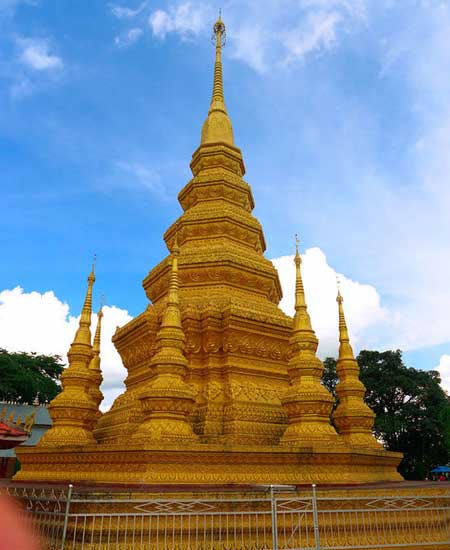JingEn Pagoda of Menghun Town in Menghai County, XishuangBanna
The JingEn Pagoda (景恩塔), known in the Dai language as “Ta JingEn,” is situated on GuangjingEn Mountain (广景恩山) and serves as the central Buddhist pagoda of the Menghai (勐海) area. According to inscriptions on the pagoda’s stele, it originally began as a single tower. It has undergone three repairs in the Dai years 141 (AD 779, Tang Dynasty), 1133 (AD 1771, Qing Dynasty), and 1139 (AD 1777). Subsequently, in the Dai year 1315 (AD 1953), during one of its repairs, four smaller pagodas were added. Due to various reasons, the pagoda was later destroyed but was rebuilt to its original appearance in 1983.
Structure and Design (塔的结构与设计)
The JingEn Pagoda (景恩塔) features a brick and stone structure, characterized as a group pagoda in the style of an octagonal diamond throne. It consists of a total of nine towers, varying in size. The base of the main tower has a square shape with sides measuring 17 meters, while the main tower stands 17.2 meters tall, and the surrounding smaller towers each reach a height of 6 meters.
The pagoda has a multi-faceted design resembling a string of beads, with the seat styled as an octagonal Sumeru base. The body and base of the pagoda are adorned with floral designs and vivid images of dragon-like creatures. The pagoda’s pinnacle consists of various elements, including a treasure vase (宝瓶), chakra (相轮), precious umbrella (宝盖), and wind chimes (风铃).
Overall, the pagoda is grand and magnificent, with exquisite decorative painting, making it an architectural gem rich in artistic value and ethnic characteristics. It has been designated as a county-level cultural heritage protection unit.
How to Get There
- By Air: Fly into Xishuangbanna Gasa Airport (西双版纳嘎洒机场), then take a taxi or local transport to Menghai County (勐海县).
- By Bus: Several bus lines connect Jinghong City (景洪市) with Menghai County (勐海县), making it accessible for travelers.
- By Car: If driving, follow signs to Menghai County (勐海县) from Jinghong City (景洪市), approximately 80 kilometers away.
Travel Tips
- Best Time to Visit: The ideal visiting period is between October and April, when the weather is pleasant for sightseeing.
- Dress Appropriately: As a religious site, visitors should dress modestly and respectfully.
- Photography: Capture the stunning architecture and intricate details of the pagoda, but be mindful of any restrictions on photography inside.
- Guided Tours: Consider joining a guided tour to learn more about the history and significance of the pagoda and the surrounding area.
- Respect Local Customs: Observe local customs and practices, especially when interacting with the local Buddhist community.















